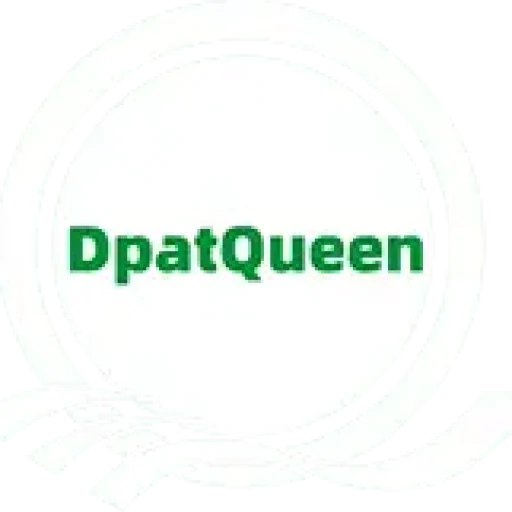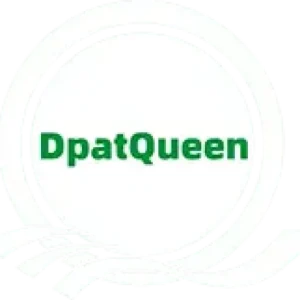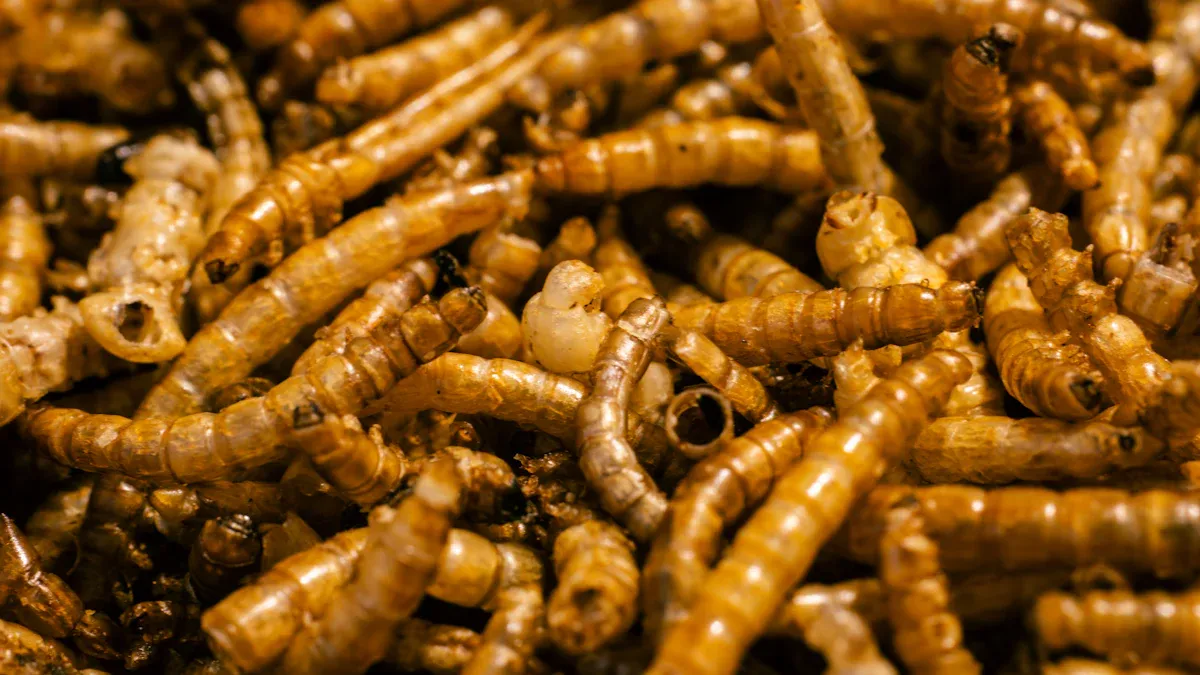
When I think about Mediterranean aquaculture, I can’t help but notice the growing problems with traditional fishmeal. Did you know that over 69% of fishmeal and 75% of fish oil go straight to feeding farmed fish? This heavy reliance has caused overfishing of species like anchovies and herring, with some populations collapsing entirely. If this continues, the demand for fishmeal could outstrip the supply of small fish by 2037.
That’s where mealworms come in. These tiny insects offer a sustainable solution. They’re packed with protein and can replace up to 30% of fishmeal protein in diets for giant grouper without affecting growth. Plus, the mealworm market is booming, growing at 7.4% annually. Mealworm for fish farms isn’t just a concept—it’s a game-changer. With the rise of mealworm manufacturers, we are seeing innovative approaches to aquaculture that could help alleviate the pressure on our oceans.
Key Takeaways
- Mealworms can take the place of 30% of fishmeal. They help fish grow well and stay healthy.
- Growing mealworms on organic waste lowers harmful gases. It also saves land and water, making it good for the planet.
- The mealworm business is growing fast. It helps fish farmers save money and protect the environment.
Nutritional and Environmental Advantages of Mealworm for Fish Farms
High Protein Content and Balanced Nutritional Profile
When I first learned about mealworms, I was amazed by their nutritional value. They’re like tiny powerhouses of protein! Did you know that mealworms contain around 50% protein by dry weight? That’s comparable to, or even better than, traditional fishmeal. Plus, they’re packed with essential amino acids, which are crucial for fish growth and health.
Here’s a quick comparison to show how mealworms stack up against fishmeal:
| Nutritional Aspect | Mealworms | Traditional Fishmeal |
|---|---|---|
| Protein Content | ~50% by dry weight | Varies, generally lower |
| Essential Amino Acids | Present | Present |
| Lipid Content | Includes unsaturated fatty acids | Varies |
| Farming Method | Can be farmed on organic waste | Relies on wild-caught fish |
| Resource Efficiency | Requires less land and water | Higher resource use |
| Environmental Impact | Reduces food waste, lowers carbon footprint | Contributes to overfishing |
This balanced nutritional profile makes mealworms an excellent choice for fish farms. Whether it’s salmon, grouper, or sablefish, studies show that fish fed mealworm-based diets grow just as well as those fed traditional fishmeal.
Reduced Carbon Emissions and Resource Use
Switching to mealworms isn’t just good for fish—it’s great for the planet too. Producing mealworms generates far fewer greenhouse gases like CO2 and methane compared to fishmeal production. They also need less land and water to produce the same amount of protein.
Here’s something that really stood out to me: mealworms can be farmed on organic waste. This means they’re not only reducing emissions but also helping to recycle food waste. It’s a win-win for sustainability and aquaculture.
Transforming Agricultural By-products into Feed
One of the coolest things about mealworms is their ability to thrive on agricultural by-products. Imagine turning leftover fruits, vegetables, or grains into high-protein feed for fish farms. Mealworms make this possible. They’re incredibly efficient at converting waste into protein-rich biomass, with protein content ranging from 40.7% to 52.3%.
This process doesn’t just reduce food waste—it also supports sustainable fish farming. By using mealworms, we can create a circular system where waste becomes a resource. It’s a smart way to feed fish while protecting the environment.
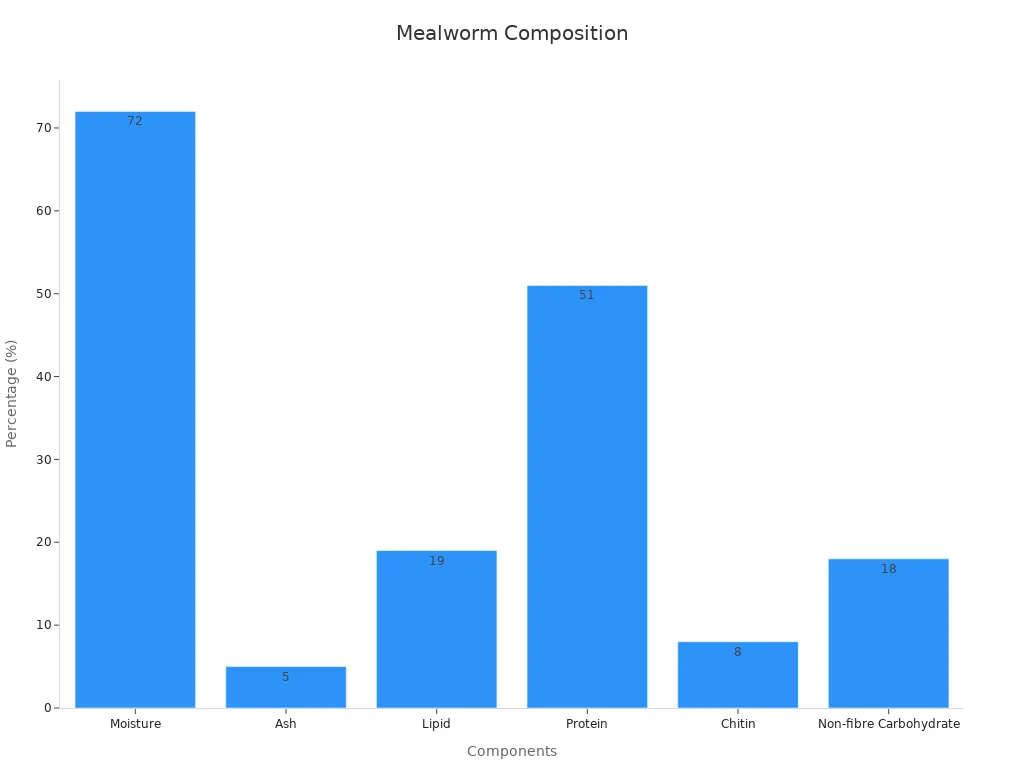
Economic Viability of Mealworm for Fish Farms
Cost-Effectiveness Compared to Fishmeal
When I first looked into mealworms as a fish feed alternative, I wondered about the costs. At first glance, mealworm production can seem pricey because it uses more energy than fishmeal. But here’s the catch—mealworms can be farmed on organic waste. This reduces feed costs for aquaculture businesses over time. Plus, they can replace up to 30% of fishmeal protein in fish diets without affecting growth. That’s a big deal for fish farmers looking to cut expenses while maintaining quality.
Another thing I found fascinating is the long-term savings. While the initial costs might be higher, mealworms offer a sustainable solution that pays off. They help reduce reliance on overfished species and imported feed, which can be expensive. It’s a smart investment for the future of aquaculture.
Scalability and Local Production Potential
One of the coolest things about mealworms is how easy they are to scale. They don’t need much space or water, making them perfect for regions with limited resources. Did you know a single female mealworm can lay 400-500 eggs? With such a high reproductive rate and quick incubation period, mealworms can be bred in small spaces and still produce a lot of protein.
I also love that mealworms can be reared locally. This enhances food security and reduces the need for imported feed. Innovations in farming techniques are making production even more efficient. With the mealworm feed market projected to grow at a compound annual growth rate of 12.9% from 2024 to 2031, the potential is huge.
Profitability Through Efficient Nutrient Utilization
Mealworms are like little nutrient factories. They convert organic waste into protein-rich biomass with incredible efficiency. This means fish farms can get more bang for their buck. By using mealworms, farmers can reduce feed costs and improve profitability. It’s a win-win for the environment and the economy.
What’s more, mealworms’ high protein content ensures fish grow just as well as they would on traditional fishmeal. This efficient nutrient utilization makes mealworms a game-changer for fish farms. It’s exciting to think about how this could transform the industry.
Practical Integration and Future Potential
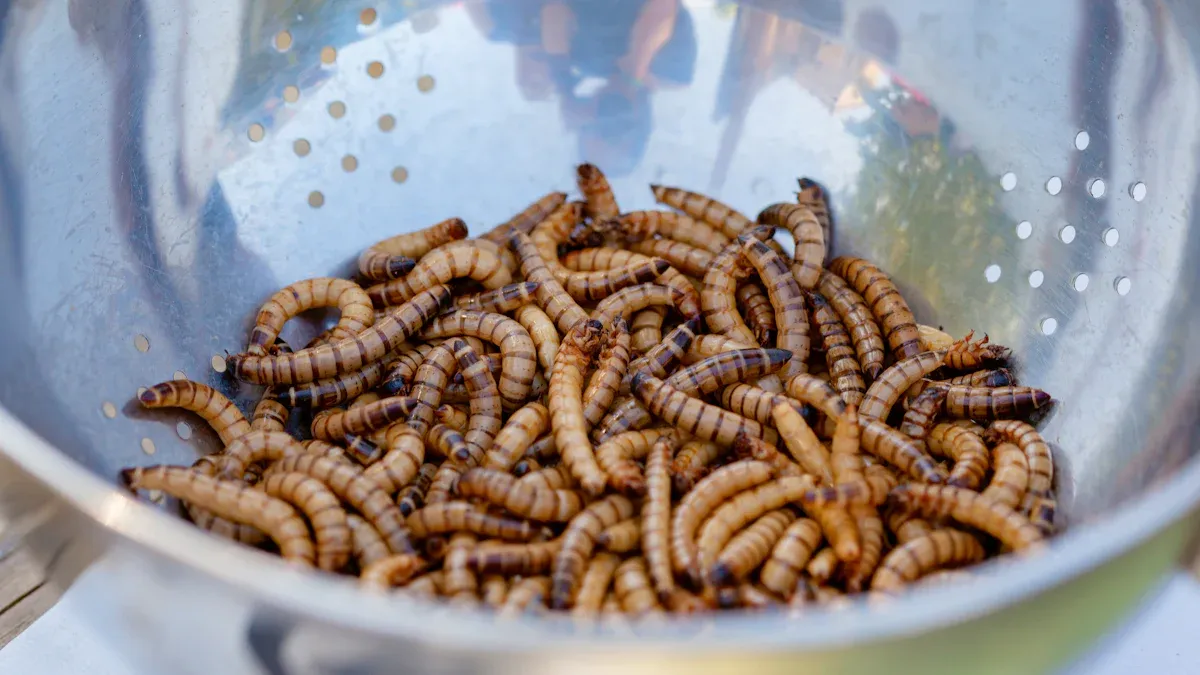
Incorporating Mealworms into Existing Aquaculture Systems
I’ve always been curious about how new ideas fit into existing systems. When it comes to mealworms, the integration into aquaculture is surprisingly straightforward. Fish farms can easily incorporate mealworm-based feed into their current operations without major overhauls. Mealworms can be processed into pellets or powders, making them compatible with standard feeding equipment. This means fish farmers don’t have to invest in expensive new machinery.
What’s even better is that mealworms can be farmed locally, reducing the need for long-distance transportation. This not only cuts costs but also lowers the carbon footprint of fish farming. I’ve seen studies showing that mealworms thrive on organic waste, which means farms can create a sustainable loop by using agricultural by-products to grow mealworms. It’s like turning waste into gold for fish farms.
Real-World Examples of Successful Implementation
I love seeing real-world success stories, and mealworms have plenty. For example:
- Shrimp farms that replaced fishmeal entirely with mealworms reported increased shrimp body weight and lipid content.
- Some fish farms have already started using mealworm-based feed, and the results show no compromise in fish growth or health.
These examples prove that mealworms aren’t just a theoretical solution. They’re already making a difference in aquaculture.
Innovations in Feed Formulation and Industry Growth
The future of mealworms in aquaculture looks bright, thanks to ongoing innovations. AI-powered systems now monitor mealworm growth conditions, making production more efficient. Advanced image recognition technology helps sort and process mealworms, ensuring high-quality feed with minimal waste.
I’ve noticed that consumer demand for sustainable protein sources is driving this growth. People are becoming more aware of environmental issues, and mealworms offer a solution with a lower environmental impact. They require less land, water, and food compared to traditional livestock. Plus, they produce fewer greenhouse gases. This makes them a perfect fit for the growing need for eco-friendly protein options.
Regulatory support for insect farming is also encouraging investment in this sector. With global protein demand rising, mealworms are positioned to play a key role in the future of aquaculture. I can’t wait to see how this industry evolves.
Mealworms are revolutionizing Mediterranean aquaculture. They reduce carbon footprints, conserve resources, and transform waste into valuable protein. For example, a trout farm in Jordan cut its reliance on imported fishmeal while lowering emissions.
| Benefit | Mealworms | Traditional Protein Sources |
|---|---|---|
| Land Use | Requires less land | Requires large areas |
| Water Use | Requires less water | Requires massive amounts |
Let’s embrace mealworms to build a sustainable future!
FAQ
What makes mealworms a sustainable choice for fish farms?
Mealworms are sustainable because they thrive on organic waste and require fewer resources like land and water. They also reduce the environmental impact of aquaculture.
Can mealworms fully replace fishmeal in aquaculture?
Not yet, but they can replace up to 30% of fishmeal protein in fish diets without affecting growth. This makes mealworm for fish farms a practical alternative.
Are mealworms safe for fish?
Yes! Mealworms are safe and nutritious. They provide essential amino acids and healthy fats, ensuring fish grow strong and healthy without compromising their diet.
